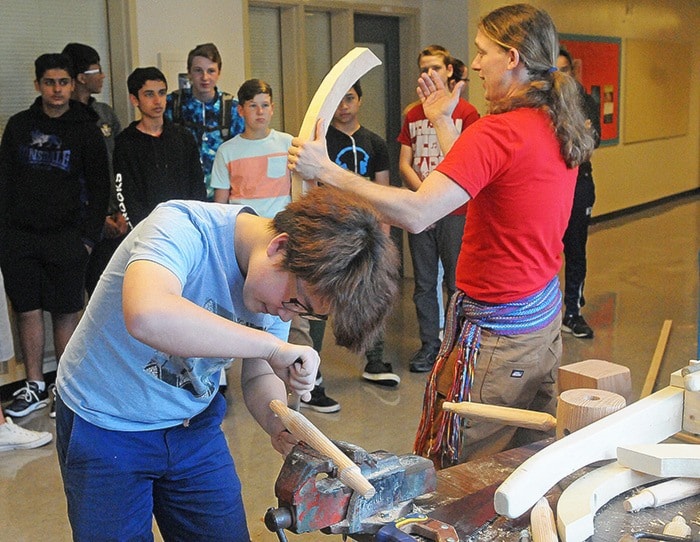A Metis carver is making the rounds through high schools in Maple Ridge and Pitt Meadows, building the traditional vehicle of his people, and sharing with students what he knows about both native history and woodworking.
Patrick Calihou has been at Pitt Meadows secondary, building a Red River cart, and soon he is moving on to Westview.
“We are always looking for ways to bring some cultural understanding into the schools,” said Ron Lanzarotta, the district principal of aboriginal education.
Ten schools had totem carving projects in recent years, and button blankets provided more cultural activities.
Now the goal is to have Calihou visit every high school in the district and build one of the historic carts there, between now and the end of June.
The carts will stay behind, and in Pitt Meadows it will go in the library and be used to display first nations books and materials.
Calihou tells the story of the carts while he works.
“It’s one of the original vehicles we used to move our furs,” he explains.
The Red River cart was as symbolic of the Metis as the birch bark canoe was of the Voyageurs.
These two-wheeled oxcarts were crafted completely out of wood, due to the lack of metal the Metis had at their disposal.

The wooden carts, reinforced with stretched buffalo hide, called shaganappi, could be stacked high with hides, food and other trade goods. A single cart could take loads up to 450 kg.
Long trains of them were the mode of shipping across the prairies in the early 1800s, and they remained popular until the CPR line was built, finished in 1885.
The carts could not use axle grease like those with metal parts because dirt and grit would get stuck in the grease and wear away the axle.
The resulting wood-on-wood created a cacophony that had the carts nicked “the North West Fiddle,” and sound of a cart train could reportedly be heard from miles away.
Calihou is making a scaled-down replica, about one-third the dimensions of its full-sized forebears, he estimates.
He tells students about the project, and individual kids have asked to join in the work. On Friday, two boys were helping drill holes with a hand drill, and cutting pieces of dowel, which were be glued to hold the cart together – even nails were not used in the carts.
The students use hand tools like chisels, mallets and hand saws, making it a more authentic experience, and nobody loses a finger, Calihou said.
“Everyone’s welcome to come and help.”
Sheldon Kidd and Aiden Douglas got out of other classes to help.
“I just find the project interesting, and it’s fun to do the work together,” said Kidd, who has Kwantlen heritage.
Calihou also carves paddles and builds canoes in traditional fashion, and he had a Pitt Meadows student he has inspired to start carving a paddle of his own.
It’s Calihou’s first time working in a school setting.
“It’s pretty exciting. The kids love it,” he said. “I’m the last carver in my family, and to be able to come here and do this with these kids is a dream come true.”
Lazarotta explained the Metis Nation of B.C. helped provide funding for the projects, local principals all jumped on the bandwagon, and Calihou provides the expertise and energy.
“He is very enthusiastic about bringing the Metis culture back to awareness,” said Lanzarotta.
